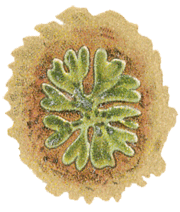
Ecology - Habitats - Bryophytes in arid areas
Biological soil crusts
In many of the world's drier areas extensive carpets of lichens, bryophytes and cyanobacteria play important ecological roles. Such carpets are called biological soil crusts and one of their major functions is erosion control. Both lichens and bryophytes commonly have root-like structures (but not true roots) to anchor themselves to the soil. In bryophytes these are called rhizoids ![]() and in lichens they are called rhizines. The small book listed in the reference button gives an excellent introduction to these soil crusts, with photographs of many of the crust-forming species found in Australia
and in lichens they are called rhizines. The small book listed in the reference button gives an excellent introduction to these soil crusts, with photographs of many of the crust-forming species found in Australia![]() .
.
In dry areas rainfall is typically infrequent but when it does rain it may pour torrentially with tremendous force. Such a downpour, hitting bare soil, would quickly churn up the ground and erode the land. A bryophyte or lichen carpet can greatly reduce or even negate the erosive potential of a massive downpour. In the first instance the biological crust takes the brunt of the falling raindrops and absorbs much of the impact. Moreover, bryophytes and various arid area lichens will absorb and retain a lot of water, though in a heavy downpour much water will still spread out. However, a healthy and diverse crust gives the soil an irregularly raised and roughened surface which slows the flow of water. Those surface irregularities also mean that, in an extensive crust, there is an abundance of tiny depressions. While each depression may be quite small, a great amount of water can be trapped by an extensive crust. By slowing or trapping the flow, healthy crusts give the water more time in which to infiltrate the underlying soil and also gives any suspended soil particles a greater chance of settling out from the water. The precise rate of water infiltration into the soil in any particular area will depend on the make-up of the soil crusts in that area and the nature of the underlying soil. For example, soils with a high clay content typically have a low infiltration rate, regardless of the presence or absence of an overlying crust. Crusts that are rough and irregular, rather than flat, lead to a higher infiltration rate. That is understandable, since a rough surface provides more obstacles to water flow and more opportunities for pooling.
The following pair of photographs (which can be enlarged) show how dramatically some of the biological soil crust organisms react to water. The photographs depict an artificial set-up, in that these specimens were not all growing in the one, small area. However, they were all collected from the dry western half of New South Wales. The photo on the left shows the scene when dry and the photo on the right shows the same scene wet. The response to water was quite rapid. It took only a minute or two for the transformation. Following this pair of photographs is a third image, providing a key to what you see in the dry/wet pair.
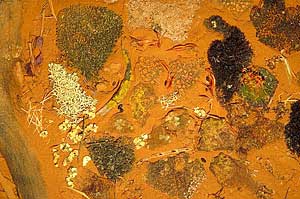 |
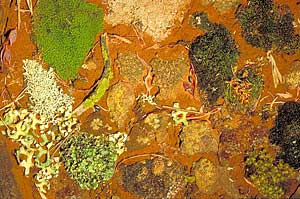 |
The following image helps explain what is shown in the previous two photos. The yellow dots indicate lichens, the blue dots show mosses and the one liverwort is marked by a red dot.
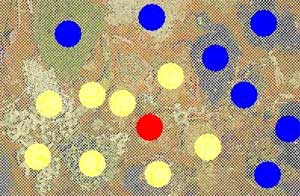 |
yellow = lichen blue = moss red = liverwort |
Biological crusts also protect against wind erosion since the various organisms constituting such crusts bind soil grains. Experimental studies have shown that crust-free soils are subject to erosion at much lower wind speeds than is the case when the soil has a healthy biological crust.
A good crust creates niches for a variety of tiny invertebrates. Amongst these are species which burrow into the underlying soil, so creating micro-channels through which water can penetrate into the ground. Amongst the smaller invertebrates that shelter in bryophytes and lichens are those that are essential in the decomposition and mineralization processes in arid areas. The crusts also provide niches for seed germination. The crusts hold on to water at least a little longer than does bare soil and also give the underlying soil some protection against direct sunlight. All this may not seem like much, but it can be enough to help a young seedling (with its fine roots) become established.
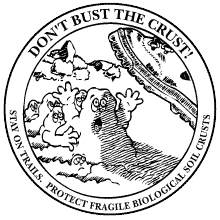 The biological soil crusts in arid areas are well-adapted to life in exposed, harsh environments but are susceptible to damage from heavy impacts. Examples of damaging actions are overstocking of livestock in arid-area grazing lands and recreational activities such as off-road driving and walking. The crusts can tolerate some damage but recovery is very slow once they have been severely damaged. Recreational activities are recognized as potential threats in some of the highly-visited national parks in the USA, hence the use of the accompanying sign in a number of arid-area parks.
The biological soil crusts in arid areas are well-adapted to life in exposed, harsh environments but are susceptible to damage from heavy impacts. Examples of damaging actions are overstocking of livestock in arid-area grazing lands and recreational activities such as off-road driving and walking. The crusts can tolerate some damage but recovery is very slow once they have been severely damaged. Recreational activities are recognized as potential threats in some of the highly-visited national parks in the USA, hence the use of the accompanying sign in a number of arid-area parks.
This excellent website, http://www.soilcrust.org, created within the US Geological Survey, provides more information and illustrations![]() .
.
![An Australian Government Initiative [logo]](/images/austgovt_brown_90px.gif)

